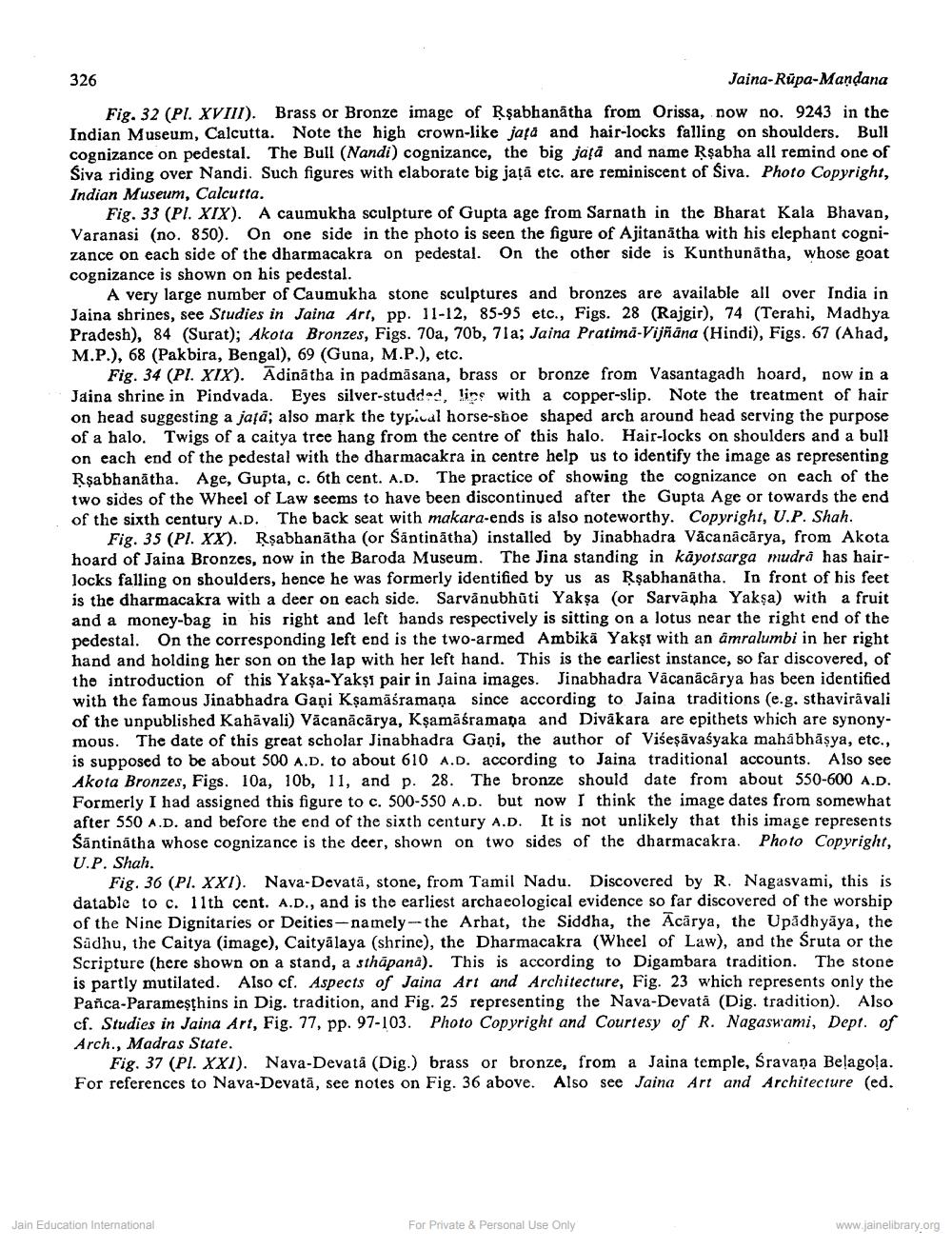________________
326
Jaina-Rūpa-Mandana
Fig. 32 (Pl. XVIII). Brass or Bronze image of Rşabhanātha from Orissa, now no. 9243 in the Indian Museum, Calcutta. Note the high crown-like jaja and hair-locks falling on shoulders. Bull cognizance on pedestal. The Bull (Nandi) cognizance, the big jaja and name Rşabha all remind one of Siva riding over Nandi. Such figures with elaborate big jață etc. are reminiscent of Siva. Photo Copyright, Indian Museum, Calcutta.
Fig. 33 (PI. XIX). A caumukha sculpture of Gupta age from Sarnath in the Bharat Kala Bhavan, Varanasi (no. 850). On one side in the photo is seen the figure of Ajitanātha with his elephant cognizance on each side of the dharmacakra on pedestal. On the other side is Kunthunātha, whose goat cognizance is shown on his pedestal.
A very large number of Caumukha stone sculptures and bronzes are available all over India in Jaina shrines, see Studies in Jaina Art, pp. 11-12, 85-95 etc., Figs. 28 (Rajgir), 74 (Terahi, Madhya Pradesh), 84 (Surat); Akota Bronzes, Figs. 70a, 706, 71a; Jaina Pratima-Vijñana (Hindi), Figs. 67 (Ahad, M.P.), 68 (Pakbira, Bengal), 69 (Guna, M.P.), etc.
Fig. 34 (Pl. XIX). Adinātha in padmāsana, brass or bronze from Vasantagadh hoard, now in a Jaina shrine in Pindvada. Eyes silver-studded, line with a copper-slip. Note the treatment of hair on head suggesting a jaja; also mark the typical horse-shoe shaped arch around head serving the purpose of a halo. Twigs of a caitya tree hang from the centre of this halo. Hair-locks on shoulders and a bull on each end of the pedestal with tho dharmacakra in centre help us to identify the image as representing Rşabhanātha. Age, Gupta, c. 6th cent. A.D. The practice of showing the cognizance on each of the two sides of the Wheel of Law seems to have been discontinued after the Gupta Age or towards the end of the sixth century A.D. The back seat with makara-ends is also noteworthy. Copyright, U.P. Shah.
Fig. 35 (Pl. XX). Rşabhanātha (or Säntinātha) installed by Jinabhadra Vāca nācārya, from Akota hoard of Jaina Bronzes, now in the Baroda Museum. The Jina standing in kayotsarga mudrá has hairlocks falling on shoulders, hence he was formerly identified by us as Rşabhanātha. In front of his feet is the dharmacakra with a deer on each side. Sarvanubhūti Yaksa (or Sarvāpha Yakşa) with a fruit and a money-bag in his right and left hands respectively is sitting on a lotus near the right end of the pedestal. On the corresponding left end is the two-armed Ambika Yakşk with an amralumbi in her right hand and holding her son on the lap with her left hand. This is the earliest instance, so far discovered, of the introduction of this Yakşa-Yakşi pair in Jaina images. Jinabhadra Vacanācārya has been identified with the famous Jinabhadra Gapi Kşamāśramana since according to Jaina traditions (e.g. sthaviravali of the unpublished Kahāvali) Vācanācārya, Kşamāśramana and Divakara are epithets which are synonymous. The date of this great scholar Jinabhadra Gani, the author of Viśeşāvaśyaka mahabhāşya, etc., is supposed to be about 500 A.D. to about 610 A.D. according to Jaina traditional accounts. Also see Akota Bronzes, Figs. 10a, 105, 11, and p. 28. The bronze should date from about 550-600 A.D. Formerly I had assigned this figure to c. 500-550 A.D. but now I think the image dates from somewhat after 550 A.D. and before the end of the sixth century A.D. It is not unlikely that this image represents Sāntinātha whose cognizance is the deer, shown on two sides of the dharmacakra. Photo Copyright, U.P. Shah.
Fig. 36 (Pl. XXI). Nava-Devata, stone, from Tamil Nadu. Discovered by R. Nagasvami, this is datable to c. 11th cent. A.D., and is the earliest archaeological evidence so far discovered of the worship of the Nine Dignitaries or Deities - namely--the Arbat, the Siddha, the Ācārya, the Upadhyāya, the Sadhu, the Caitya (image), Caityalaya (shrine), the Dharmacakra (Wheel of Law), and the Sruta or the Scripture (here shown on a stand, a sthapana). This is according to Digambara tradition. The stone is partly mutilated. Also f. Aspects of Jaina Art and Architecture, Fig. 23 which represents only the Panca-Parameshins in Dig. tradition, and Fig. 25 representing the Nava-Devatá (Dig. tradition). Also cf. Studies in Jaina Art, Fig. 77, pp. 97-103. Photo Copyright and Courtesy of R. Nagaskami, Dept. of Arch., Madras State.
Fig. 37 (Pl. XXI). Nava-Devatá (Dig.) brass or bronze, from a Jaina temple, Sravana Belagoļa. For references to Nava-Devatā, see notes on Fig. 36 above. Also see Jaina Art and Architecture (ed.
Jain Education International
For Private & Personal Use Only
www.jainelibrary.org




